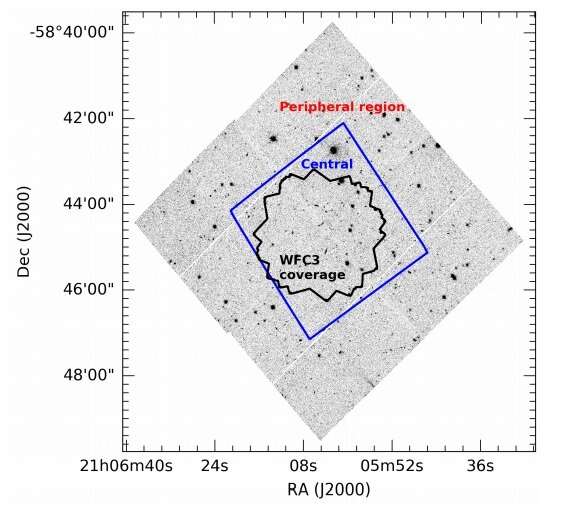October 22, 2019 report
SPT-CL J2106-5844 is the most massive high-redshift galaxy cluster, study finds

Using data from the Hubble Space Telescope (HST), astronomers have conducted a detailed high-resolution study of a massive galaxy cluster known as SPT-CL J2106-5844. The research, presented in a paper published October 10 on arXiv.org, delivers precise mass determination of SPT-CL J2106-5844, finding that it is the most massive high-redshift galaxy cluster known to date.
Galaxy clusters consists of up to thousands of galaxies bound together by gravity. They are the largest gravitationally bound structures, and could therefore be crucial in improving the knowledge about large-scale structure formation and evolution of the universe.
At a redshift of about 1.13, SPT-CL J2106-5844 (SPT2106 for short), is a high-mass galaxy cluster discovered in 2011 as part of the South Pole Telescope Sunyaev-Zel'dovich (SPT-SZ) survey. According to previous observations, SPT2106 has a high X-ray temperature of about 11 keV, luminosity at a level of approximately 1.39 quattuordecillion erg/s, and a velocity dispersion of around 1,230 km/s. These values suggest that the cluster could be extremely massive.
Although several observations of SPT2106 have been conducted, astronomers are still uncertain about its exact mass. Some studies indicate that it has a virial mass of 880 trillion solar masses, while other point to a virial mass of nearly 1,300 trillion solar masses.
In order to put more constraints on the mass of SPT2106, a team of astronomers led by Jinhyub Kim of Yonsei University in Seoul, South Korea, has performed a detailed, high-resolution weak-lensing study of this galaxy cluster by analyzing deep HST imaging data.
"In this paper, we present a detailed WL [weak-lensing] analysis of SPT2106 using ACS [Advanced Camera for Surveys] and Wide Field Camera 3 (WFC3) data. (...) From the deep HST imaging data, we achieve a source density of 169 arcmin−2 in the WFC3/IR field, which enables us to perform a high-resolution mass reconstruction and improve the precision in mass estimation," the astronomers wrote in the paper.
The study found that the mass distribution in SPT2106 is asymmetric. Analyzing the images, the scientists distinguished a main mass clump and a subclump located about 2.1 million light years west from the main clump. Observations show that the main clump is further divided into two smaller northwestern and southeastern structures separated by some 500,000 light years from each other.
In particular, when it comes to the location of the two substructures of the subclump, the northwestern mass peak position agrees with that of the X-ray peak, coinciding with the position of the brightest cluster galaxy of SPT2106. The data suggest that the southeastern peak seems to be associated with the number density peak. Taking into account such morphology and the properties of X-ray emission in SPT2106, the astronomers concluded that the galaxy cluster might be a merging system.
The virial mass of SPT2106 was calculated at approximately 1,040 trillion solar masses. The researchers noted that this value is in agreement with previous estimates, however, it is much more precise, given that the statistical uncertainty is about 40 percent smaller than the previous weak-lensing result. Hence, the new calculations confirm that SPT2106 is the most massive galaxy cluster among such objects with redshift higher than 1.0.
More information: Precise mass determination of SPT-CL J2106-5844, the most massive cluster at z>1, arXiv:1910.04775 [astro-ph.CO] arxiv.org/abs/1910.04775
© 2019 Science X Network




















